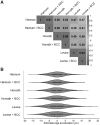Methylation-Based Biological Age and Breast Cancer Risk
- PMID: 30794318
- PMCID: PMC6792078
- DOI: 10.1093/jnci/djz020
Methylation-Based Biological Age and Breast Cancer Risk
Abstract
Background: Age is one of the strongest predictors of cancer, chronic disease, and mortality, but biological responses to aging differ among people. Epigenetic DNA modifications have been used to estimate "biological age," which may be a useful predictor of disease risk. We tested this hypothesis for breast cancer.
Methods: Using a case-cohort approach, we measured baseline blood DNA methylation of 2764 women enrolled in the Sister Study, 1566 of whom subsequently developed breast cancer after an average of 6 years. Using three previously established methylation-based "clocks" (Hannum, Horvath, and Levine), we defined biological age acceleration for each woman by comparing her estimated biological age with her chronological age. Hazard ratios and 95% confidence intervals for breast cancer risk were estimated using Cox regression models. All statistical tests were two-sided.
Results: Each of the three clocks showed that biological age acceleration was statistically significantly associated with increased risk of developing breast cancer (5-year age acceleration, Hannum's clock: hazard ratio [HR] = 1.10, 95% confidence interval [CI] = 1.00 to 1.21, P = .04; Horvath's clock: HR = 1.08, 95% CI = 1.00 to 1.17, P = .04; Levine's clock: HR = 1.15, 95% CI = 1.07 to 1.23, P < .001). For Levine's clock, each 5-year acceleration in biological age corresponded with a 15% increase in breast cancer risk. Although biological age may accelerate with menopausal transition, age acceleration in premenopausal women independently predicted breast cancer. Case-only analysis suggested that, among women who develop breast cancer, increased age acceleration is associated with invasive cancer (odds ratio for invasive = 1.09, 95% CI = 0.98 to 1.22, P = .10).
Conclusions: DNA methylation-based measures of biological age may be important predictors of breast cancer risk.
Published by Oxford University Press 2019. This work is written by US Government employees and is in the public domain in the US.
Figures




Comment in
-
Your DNA May Appear Older Than You Think.J Natl Cancer Inst. 2019 Oct 1;111(10):1007-1008. doi: 10.1093/jnci/djz021. J Natl Cancer Inst. 2019. PMID: 30794313 Free PMC article. No abstract available.
References
Publication types
MeSH terms
Substances
Grants and funding
LinkOut - more resources
Full Text Sources
Medical

